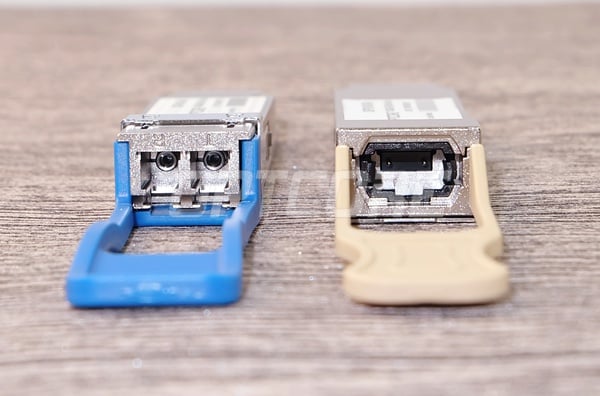Optical Transceiver
100GBASE-SR4 vs. 100GBASE-BiDi SR vs. 100GBASE-SR10: What is the difference?
In a previous blog, we talked about 100GBASE-SR4, 100GBASE-BiDi, and 100GBASE-SR10 topics, but we didn’t compare those technologies side-by-side. Therefore, we are writing this article to make a clear comparison of their fundamental differences. So, let’s get started!
100GBASE-SR4, 100GBASE-BiDi, and 100GBASE-SR10 Basics
Before we compare technologies, it’s essential to understand the basic terminology.
- 100GBASE-SR4: It uses four lanes (4x25Gbps) of transmitting/receiving the optical signal to achieve an aggregation 100Gbps data rate. “SR” stands for short reach, and “4” means four lanes of signals. The typical distance is 70m over OM3 or 100m over OM4 multimode fiber.
- 100GBASE-BiDi SR: It is the bidirectional version of 100GBASE-SR. It carries two optical signals in opposite directions on the same multimode fiber, using different wavelengths of 850nm/910nm. It takes two lanes of 50Gbps in each direction to achieve an aggregation 100Gbps data rate.
- 100GBASE-SR10: It uses ten lanes (10x10Gbps) of transmitting/receiving the optical signal to perform an aggregation 100Gbps data rate. “SR” stands for short reach, and “10” means ten lanes of signals. It also supports the same distance as 100GBASE-SR4.
Learn more: Lifting the Lid: Explaining 100G Bidirectional (BiDi) Optics
100GBASE-SR4 vs. 100GBASE-BiDi SR vs. 100GBASE-SR10: What is the difference?
Now that we know the definition of each term, let’s see how they differ from each other. The below table summarizes the key differences between 100GBASE-SR4, 100GBASE-BiDi SR, and 100GBASE-SR10.

Difference #1 – Fiber Count
100GBASE-SR4 transceiver uses 8 fibers, the most mainstream multimode fiber cabling structure for short reach 100G Ethernet. It requires four transmit and four receive fibers, usually in an MPO/MTP cabling system.
100GBASE-BiDi SR transceivers only uses 2 fibers to transmit data in both directions, and it is the most cost-effective solution when upgrading your 100G network. Undoubtedly, 100GBASE-BiDi requires the least amount of fiber cabling deployment. It is suitable for scenarios where existing multimode fiber is strained or cannot be easily redeployed with new fiber.
100GBASE-SR10 takes up the most fiber cable resources and does not meet the trend of the resource-saving data center. Therefore, it is not recommended to use a 100GBASE-SR10 transceiver when deploying a new data center. But it has an advantage other optics do not have, which is its backward compatibility with 10GBASE-SR.
Difference #2 – Fiber Connector
The different fiber count request also means different fiber connector.

100GBASE-BiDi SR transceiver uses the traditional LC duplex fiber optic connector, which is simple and easy to use.
100GBASE-SR4 and 100GBASE-SR10 transceivers both use MPO/MTP fiber optic connectors. 100GBASE-SR4 requires an 8 or 12-fiber MPO/MTP connector, and 100GBASE-SR10 needs a 20 or 24-fiber MPO/MTP connector.
Difference #3 – Wavelength
The transmit and receive optical signals of 100GBASE-SR4 and 100GBASE-SR10 are on the same 850nm wavelengths, similar to traditional Ethernet optics. In contrast, 100GBASE-BiDi uses different wavelengths for transmitting and receiving optical signals in one fiber. The typical wavelength for transmitting is 850nm, and the wavelength for receiving is 910nm. Therefore, 100GBASE-BiDi optics is a variant of WDM (wavelength-division multiplexing) optics.
Learn more: Wavelength Division Multiplexing (WDM) Tutorial
Difference #4 – Total Cost
The total cost should contain two essential aspects: 100G transceiver cost and fiber cabling cost. As a result, the final price will vary based on the cost of different 100G transceivers and fiber optic cabling. Different deployment solutions will have different total costs.
In most cases, we do not suggest using 100GBASE-SR10 because of its high fiber resource usage and inflexibility. Besides that, the 100GBASE-SR10 transceiver is much higher in price than 100GBASE-SR4 and 100GBASE-BiDi. 100GBASE-SR10 can no longer adapt to high-density data center demand in the future and will gradually leave this market.
100GBASE-SR4 transceivers provide the lowest pricing and the most common form factor for 100G QSFP28 transceivers. It is a good choice for data center deployment that requires short reach and low cost. However, the 100GBASE-SR4 optics need to use 8 fiber cables, which is difficult to deploy for a bit longer distance. It would help if you chose this option when you have enough fiber resources, and the deployment distance is not too long.
100GBASE-BiDi offers the most flexible and cost-effective 100G Ethernet solution. It only needs two fiber cables for short reach and is easy to deploy in the existing infrastructure. However, the 100GBASE-BiDi SR transceiver price is much higher than that of the 100GBASE-SR4 transceiver. You should choose this option when you upgrade your network to 100G Ethernet, and the existing infrastructure is strained.
Final Words
Hopefully, this article has helped you understand the differences between 100GBASE-SR4, 100GBASE-BiDi SR, and 100GBASE-SR10. Each has its advantages and disadvantages and is suitable for the different applications. It would help if you chose the right option according to your actual needs.
Optcore provides 100G transceivers, including 100GBASE-SR4 QSFP28, 100GBASE-BiDi SR QSFP28, and 100GBASE-SR10 CFP. All the transceivers are 100% compatible with major brands and backed by a 3-year warranty. Feel free to contact us if you have any questions or needs.
Read more:
- OPTCORE 100G QSFP28 Transceiver Solution
- 40G QSFP+ vs. 100G QSFP28 Transceiver: Pros and Cons
- Optcore QSFP28-100G-SR4 vs. QSFP28-100G-LR4 Compare, What Are The Key Differences?
- Lifting the Lid: Explaining 100G Bidirectional (BiDi) Optics
- Introduction to 100G Ethernet Technologies and Applications







